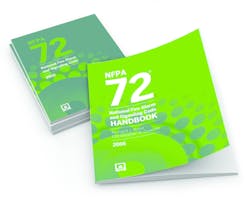Fire Alarm Code Language Redefined
The latest published edition of NFPA 72, the National Fire Alarm and Signaling Code-2016, further clarifies the fire alarm industry’s concept of traditional terms and their definitions.
The first example is the expansion of the language in the site-specific software requirements. Once your state adopts this 2016 Edition, you will not simply provide a copy of the system’s “site-specific software” – you must also ensure it will be accessible if needed and avoid locking yourselves out of the system by losing the password.
The new Section 7.5.7.1.1 specifically states: “The passwords provided shall enable certified qualified programming personnel to access, edit, modify and add to the existing system site-specific software.” The documentation you must provide “shall include both the user passcode and either the system programming password or specific instructions on how to obtain the programming password from the system manufacturer.”
Are there any old floppy discs in your customers’ documentation records? Section 7.7.2.6 of the 2016 edition has been added to make sure the digital storage format you provide for system documentation and backup will be usable when needed. The building owner or the building owner’s representative shall, on an annual basis, review any electronic documentation media formats and associated interfacing hardware for compatibility and update, if necessary.
Defining Qualified and Experienced
In the past few years, NFPA 72 has added a section that requires fire alarm personnel be “qualified and experienced” – while providing a few examples of how someone can demonstrate they are both “qualified” and “experienced.” The latest version indicates we may someday have plan reviewers and field inspectors that will also have to be able to indicate that they are up to the task.
The new section is a start, but it is only a start because it does not also include a requirement for these professionals to be “experienced.” Section 10.5.4 states that plan reviewers and inspectors must be licensed, certified or meet the requirements of NFPA 1031 – which appears to give this new section some teeth. However, subsection (3) also adds that the local code official can just assign anyone to this job and that assignment should be seen as an equal to the licensing and certification requirements of the first section – which makes you wonder if this subsection has any real bite to it.
Here’s the full text from 10.5.4 Plans Examiners and Inspectors:
10.5.4.1 Fire alarm system and emergency communications system plans and specifications submitted for review and approval shall be reviewed by personnel who are qualified to review such plans and specifications.
10.5.4.2 Fire alarm system and emergency communications system installations shall be inspected by personnel who are qualified to perform such inspections.
10.5.4.3 State or local licensure regulations shall be followed to determine qualified personnel.
10.5.4.4 Personnel shall provide documentation of their qualifications by one or more of the following: (1) Registration, licensing, or certification by a state or local authority; (2) Meeting the requirements of NFPA 1031; (3) Assignment by the authority having jurisdiction to perform plan reviews and inspections.
Fault Isolation Modules
In its updates from 2013 to 2016, NFPA 72 has again changed the mandatory use of Fault Isolation Modules. According to the 2013 edition, section 23.6.1: “A single fault on a pathway connected to the addressable devices shall not cause the loss of more than 50 addressable devices.”
Now, the 2016 edition replaced the maximum quantity of devices (50) and replaces it with the SLC zone concept: “23.6.1 SLC Zones. A single fault on a pathway connected to the addressable devices shall not cause the loss of the devices in more than one zone.
23.6.1.1 For the purpose of this section, each floor of the building shall be considered a separate zone.
23.6.1.2 For the purpose of this section, if a floor of the building is subdivided into multiple zones by fire or smoke barriers and the fire plan for the protected premises allows relocation of occupants from the zone of origin to another zone on the same floor, each [evacuation] zone on the floor shall be considered a separate zone.”
This language reduces the capacity of an addressable circuit or a branch of one. This can be accomplished in three ways: By running one main Class A SLC with an isolation module installed to provide a Class B branch for each floor/evac zone; by providing one Class A SLC using a fault isolation module to separate the SLC at each floor/evac zone; or home run each floor/evac zone back to the FACP location where you will install an Isolation Module on each of them.
This group of isolation (SLC zone) modules must be wired on the panel’s SLC and be located no more than three feet from the panel.
Whichever way you decide to best wire addressable devices, home running one or more SLCs will be now be required. The 2016 edition goes on to say that the latest SLC zone requirements do not apply to any “performance-based design approach” you can convince the AHJ into accepting.
The Annex example states this exception may allow you to combine two floors that only have a few devices each onto the same SLC zone – since losing both floors would only amount to the loss of a few devices. The address of each device will cause it to annunciate its location properly even though these two floors are on the same SLC zone.
Read more on Fault Isolation Modules in my Feb. 2016 column: www.securityinfowatch.com/12162385.
Air Pressure Valves
A totally unnecessary addition to the 2016 code was made in section 23.8.5.6.3 for air pressure valves that align a bleed hole when the valve is turned: “If a valve is installed in the connection between a sprinkler system and an initiating device, the valve shall be supervised in accordance with 17.16.1 unless the valve is arranged to cause operation of the supervisory signal initiating device when it is in its non-normal position.”
This arrangement allows the pressure to drop in the pressure supervision switch without risk of tripping the flapper valve in a dry pipe system. The existing wording already fit this valve’s supervision operation (17.16.2.1: “Two separate and distinct signals shall be initiated: one indicating that the required pressure has increased or decreased (off-normal), and the other indicating restoration of the [air] pressure to its normal value.”); thus, this high-tech bleeding off of air has traditionally been accomplished using a wrench or two to allow a loss of air pressure to trip the air pressure supervisory switch. This new manufacturer-specific language does not solve a problem or alter the existing/basic test process.
Recalled Products
Section 14.2.2.2, named “Impairments/Deficiencies” requires anyone performing a visual inspection to indicate to the system owner or their representative in writing that they have seen installed equipment that was included in a “recall program.”
Neither the code or annex material mention the enforcement of this new rule; thus, it seems the actual enforcement and timeliness of compliance with written recall notifications to the owner will be left to the courts.
Greg Kessinger has been SD&I’s fire alarm and codes expert and a regular contributor for more than 15 years. Please email him your fire & life safety questions at [email protected].
About the Author

